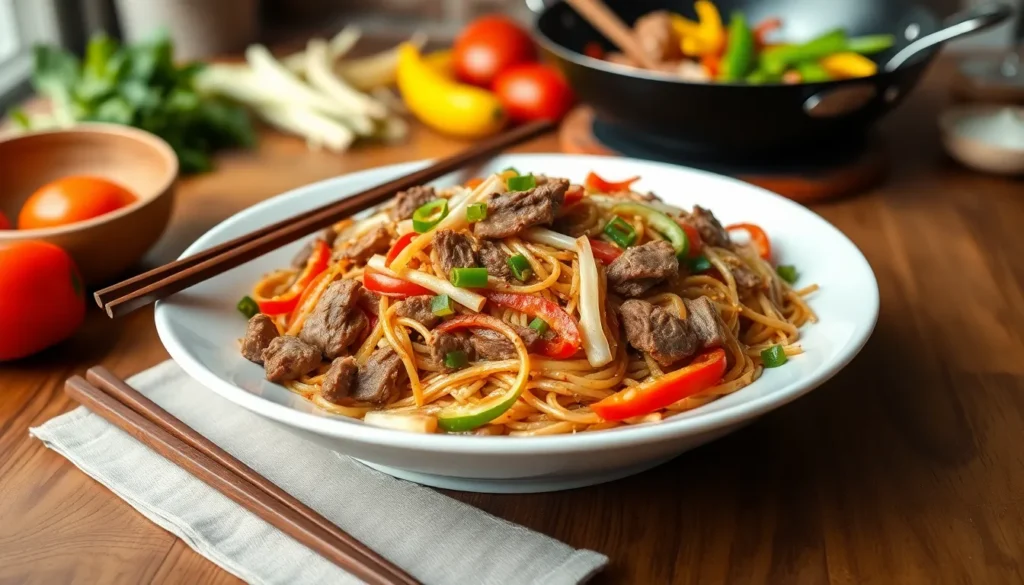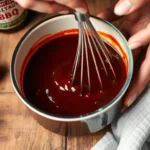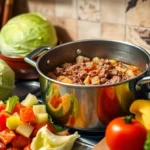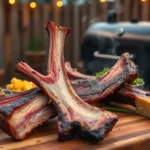Nothing beats the satisfaction of twirling tender beef and crispy vegetables around silky noodles in a savory sauce that hits all the right notes. We’ve perfected this easy beef chow mein recipe that brings authentic Chinese takeout flavors straight to your kitchen without the hefty price tag or long wait times.
This classic stir-fry dish originated in Chinese-American restaurants and quickly became a weeknight favorite for families everywhere. Our version uses simple ingredients you likely already have on hand and comes together in just 20 minutes from start to finish.
We’ll show you the secret to achieving that perfect balance of tender beef strips, crisp-tender vegetables, and perfectly cooked noodles that don’t clump together. Plus, our homemade sauce is so much better than any packet mix – it’s rich, savory, and has that restaurant-quality depth of flavor you’ve been craving.
Ingredients
We’ve organized our ingredients into three simple categories to make preparation effortless. Each component plays a crucial role in creating the perfect balance of flavors and textures.
For the Beef Marinade
- 1 pound flank steak, sliced thin against the grain
- 2 tablespoons soy sauce
- 1 tablespoon cornstarch
- 1 teaspoon sesame oil
- 1/2 teaspoon ground black pepper
For the Chow Mein
- 8 ounces fresh chow mein noodles (or dried lo mein noodles)
- 3 tablespoons vegetable oil, divided
- 1 medium onion, thinly sliced
- 2 carrots, julienned
- 1 red bell pepper, thinly sliced
- 1 cup bean sprouts
- 3 green onions, chopped
- 3 cloves garlic, minced
- 1 tablespoon fresh ginger, minced
For the Sauce
- 1/4 cup soy sauce
- 2 tablespoons oyster sauce
- 1 tablespoon dark soy sauce (for color)
- 1 teaspoon sesame oil
- 1 teaspoon sugar
- 1/2 teaspoon white pepper
- 2 tablespoons chicken broth or water
Equipment Needed
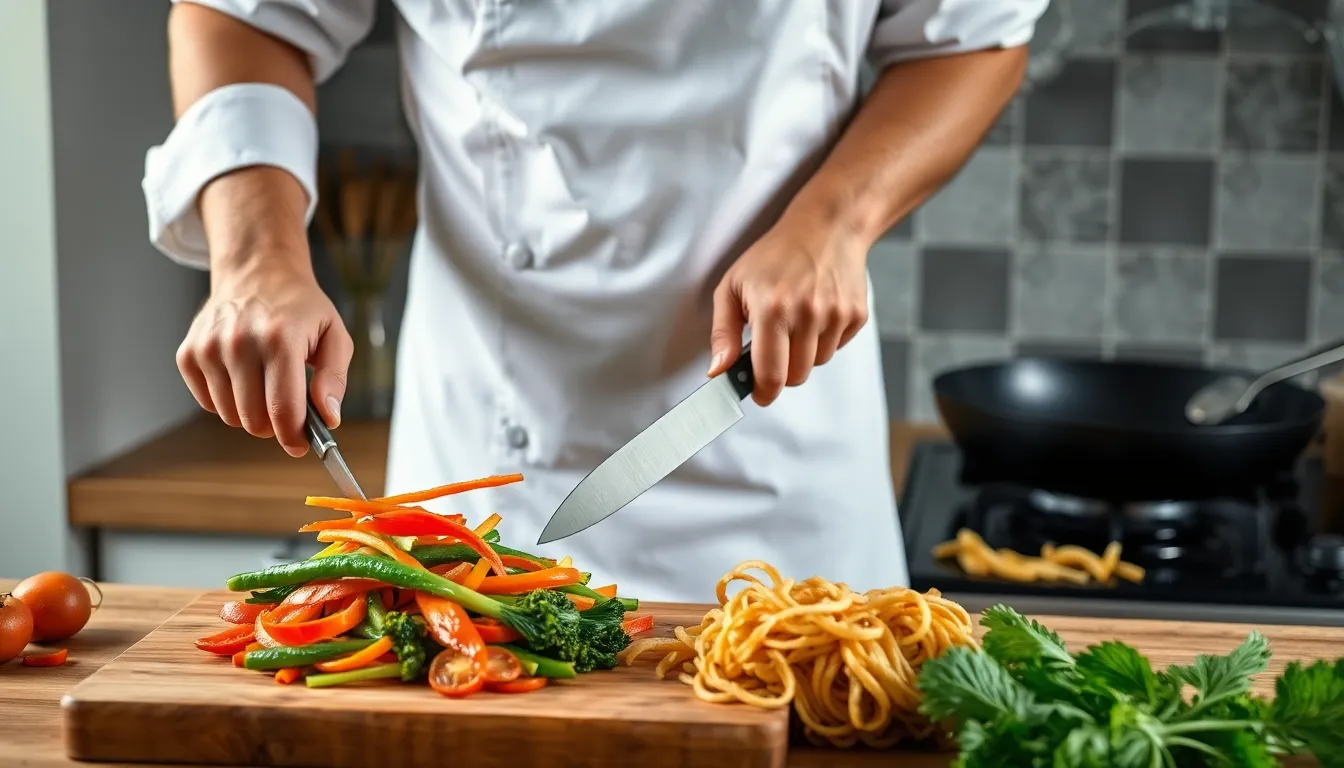
Creating the perfect beef chow mein requires the right tools to achieve restaurant-quality results at home. We recommend investing in exact equipment that makes the cooking process smoother and ensures authentic flavors.
A wok or large non-stick frying pan serves as our most essential tool for this recipe. The high-heat capacity and wide surface area allow for proper stir-frying technique, ensuring even cooking of all ingredients while maintaining the characteristic “wok hei” flavor that defines great chow mein.
Our large chopping knife becomes indispensable for efficiently slicing beef and vegetables. Sharp, precise cuts ensure uniform cooking and professional presentation of the finished dish.
Chopsticks or a spatula help us stir ingredients during the cooking process without damaging delicate noodles or vegetables. These tools provide the control needed for proper tossing and mixing techniques.
We use mixing bowls for marinating the beef and combining our sauce ingredients. Separate bowls keep flavors organized and make the cooking process more efficient when working at high heat.
A pot for boiling noodles rounds out our essential equipment list. Fresh chow mein noodles require proper cooking before stir-frying to achieve the ideal texture.
| Equipment | Primary Function | Cook Time Impact |
|---|---|---|
| Wok/Large Pan | High-heat stir-frying | 7-10 minutes |
| Sharp Knife | Beef and vegetable prep | 10-15 minutes |
| Mixing Bowls | Marinating and sauce prep | 5 minutes |
| Chopsticks/Spatula | Stirring and tossing | Throughout cooking |
| Boiling Pot | Noodle preparation | 3-5 minutes |
Having these tools ready before we start cooking ensures our total preparation and cooking time stays around 30 minutes, with most of the active cooking happening in just 7 to 10 minutes of high-heat stir-frying.
Instructions
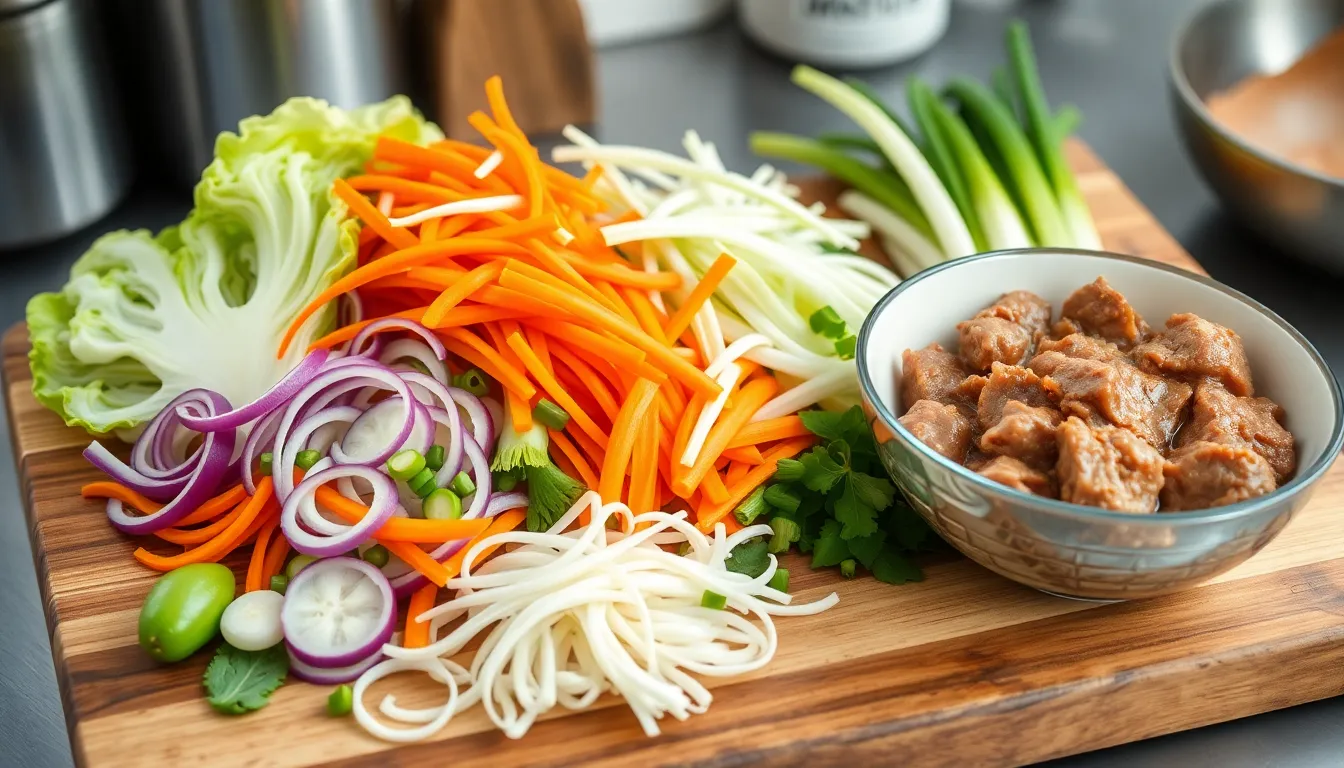
Follow these step-by-step instructions to create restaurant-quality beef chow mein in your own kitchen. The key to success lies in proper preparation and high-heat cooking that brings together all components seamlessly.
Prep the Beef
Slice ½ lb flank or skirt steak into ¼-inch thin pieces on the bias. We recommend cutting against the grain for maximum tenderness. Place the sliced beef in a mixing bowl and add 1 tbsp cold water, ½ tbsp cornstarch, ½ tbsp neutral oil, ½ tsp soy sauce, and ¼ tsp baking soda. Mix thoroughly with your hands to ensure even coating. Allow the beef to marinate while you prepare the remaining ingredients, as this tenderizing process is crucial for achieving that perfect restaurant texture.
Prepare the Vegetables
Chop 2 cups of napa or green cabbage into bite-sized pieces. Julienne 1 cup of carrots or bell peppers into thin strips for even cooking. Cut 4 green onions into 1.5-inch pieces, separating the white and green parts. Rinse 2 cups of mung bean sprouts thoroughly under cold water and drain well. Having all vegetables prepped and ready ensures smooth cooking once the stir-frying begins.
Make the Sauce
Whisk together all sauce ingredients in a medium bowl. Combine 2 tbsp oyster sauce, 2 tbsp soy sauce, 2 tbsp dark soy sauce, 1 tbsp Shaoxing wine, 1 tbsp sugar, 1 tbsp sesame oil, and 2 tsp cornstarch. Add 3 finely minced garlic cloves and ½ cup low-sodium chicken stock. Stir the mixture thoroughly until the cornstarch dissolves completely and no lumps remain. Set this sauce aside within easy reach of your cooking area.
Cook the Noodles
Bring a large pot of water to a boil. Add 1 lb fresh chow mein noodles and cook according to package directions until just tender. Fresh noodles typically require only 2-3 minutes of cooking time. Drain the noodles immediately and rinse briefly with cold water to stop the cooking process. Shake off excess water and set aside.
Stir-Fry the Beef
Heat 3 tbsp vegetable oil in your wok or large skillet over high heat until it shimmers. Add the marinated beef in a single layer, allowing it to sear without stirring for 1-2 minutes. Stir-fry the beef until it develops a beautiful caramelized exterior while remaining tender inside, approximately 2-3 minutes total. Remove the beef from the wok and transfer to a clean plate.
Combine Everything
Add more oil to the same wok if needed. Stir-fry the prepared vegetables over high heat, starting with the heartier vegetables like carrots and cabbage first. Cook for 2-3 minutes until vegetables are tender-crisp. Return the seared beef to the wok along with the cooked noodles. Pour the prepared sauce over everything and toss vigorously using chopsticks or a spatula. Continue stir-frying for 1-2 minutes until the sauce thickens and coats all ingredients evenly, creating that glossy finish that makes restaurant chow mein so appealing.
Cooking Tips for Perfect Beef Chow Mein
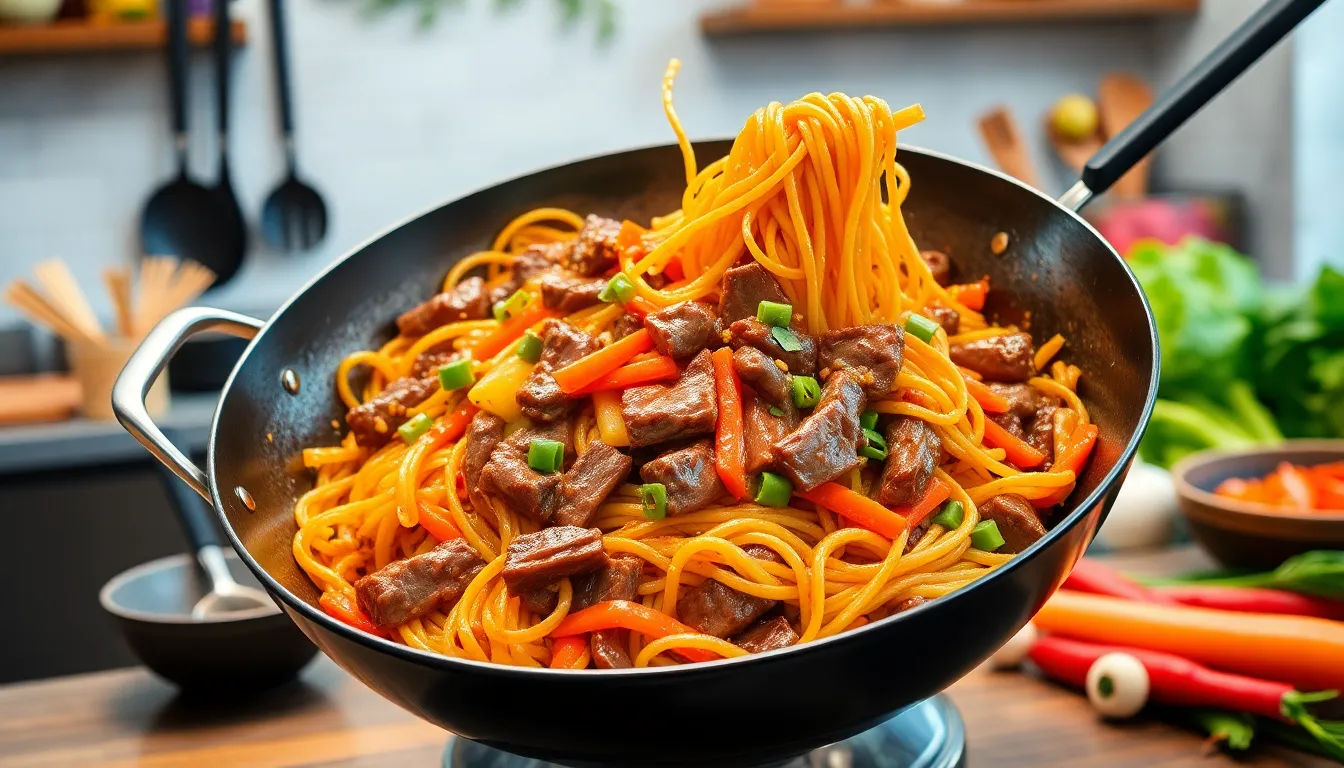
We’ve discovered that mastering beef chow mein requires attention to several key techniques that separate restaurant-quality results from mediocre home cooking. Our years of testing have revealed exact methods that consistently deliver tender beef and perfectly textured noodles.
Tenderize the beef with baking soda for restaurant-quality texture. We add ¼ teaspoon of baking soda to our marinade along with the cornstarch and soy sauce. This technique creates that signature velvety texture you find in professional kitchens. The baking soda breaks down proteins and helps the beef retain moisture during high-heat cooking.
Control your noodle cooking time to prevent mushy results. We deliberately undercook fresh chow mein noodles when boiling them initially. They should remain slightly firm since they’ll continue cooking during the stir-frying process. Semi-fresh noodles need only a brief boil while dried varieties should reach al dente or slightly less.
Master the beef stir-frying technique by working quickly over high heat. We sear the marinated beef strips rapidly until they develop a beautiful caramelized exterior while keeping the interior tender and juicy. Overcooking at this stage results in tough chewy meat that ruins the entire dish.
Balance your sauce with dual soy sauce types for optimal flavor and appearance. We combine light soy sauce for saltiness with dark soy sauce or mushroom soy sauce for rich color and deeper umami notes. This combination creates the glossy brown coating that makes chow mein visually appealing.
Add vegetables strategically to maintain their crisp texture throughout cooking. We start with harder vegetables like carrots first then add softer items like cabbage and bean sprouts toward the end. This staged approach prevents over-softening while ensuring everything reaches the proper doneness.
Achieve even coating by tossing ingredients quickly and continuously in your wok or large pan. We pour the sauce mixture over the combined noodles and beef then toss everything rapidly to distribute heat and flavoring evenly. This technique ensures every strand of noodle gets properly coated without clumping.
Variations and Substitutions
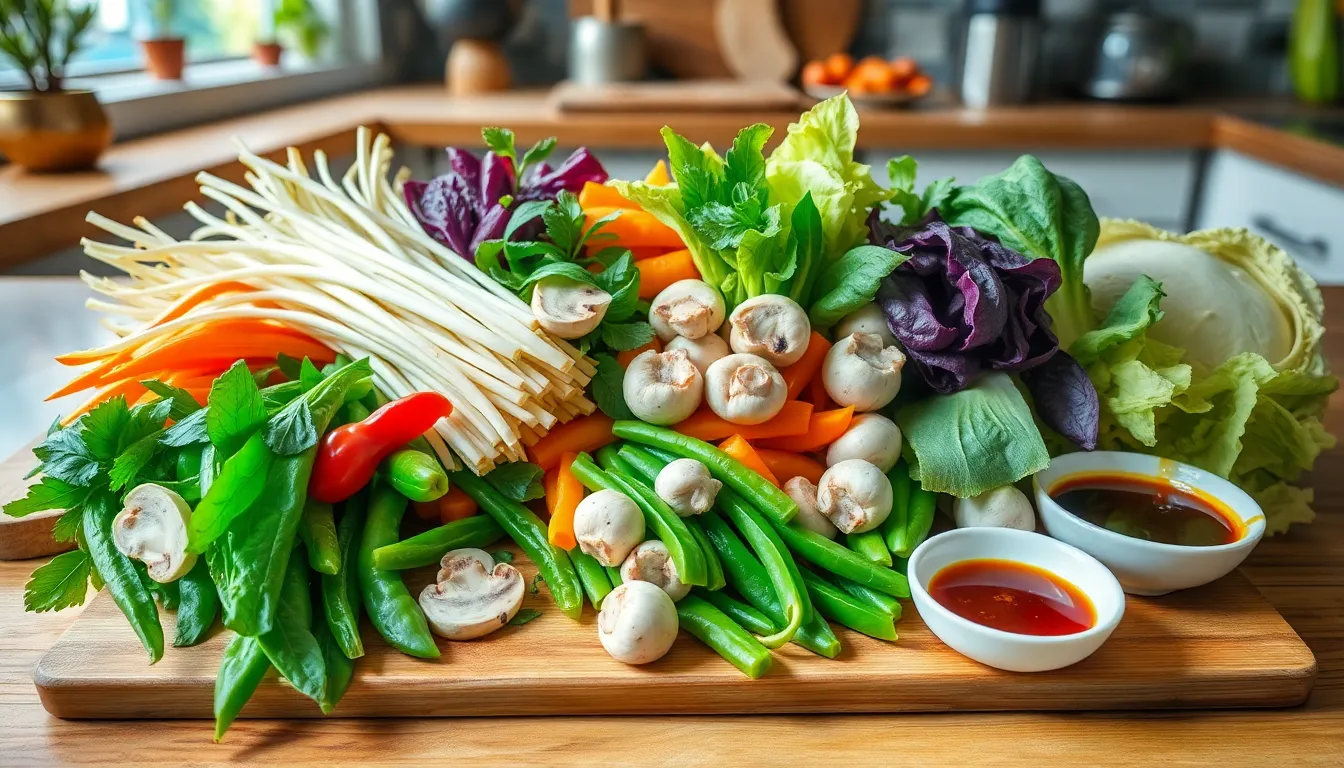
We love how versatile beef chow mein can be when you need to work with different ingredients or dietary preferences. This flexibility makes it perfect for using what you have on hand while still creating a delicious meal.
Noodle Alternatives
Fresh chow mein noodles deliver the best texture and flavor, but we understand they’re not always available. Spaghetti works as an excellent substitute and cooks similarly to traditional chow mein noodles. Yakisoba noodles provide an authentic Asian flavor profile and maintain the proper texture. Ramen noodles (without the seasoning packet) offer convenience and cook quickly for weeknight meals. Thin egg noodles create a similar mouthfeel to traditional chow mein varieties.
Protein Substitutions
Ground beef offers the most economical option and requires no slicing or marinating time. Sirloin steak provides excellent tenderness when sliced thinly against the grain. Chicken breast or thighs work beautifully when cut into strips and marinated similarly to beef. Tofu creates a satisfying vegetarian version when pressed and cubed before stir frying. Shrimp cooks quickly and adds elegant seafood flavor to the dish. Scallops and squid bring restaurant quality sophistication when properly prepared.
Vegetable Options
Bean sprouts add essential crunch and are traditional in most chow mein recipes. Bell peppers in various colors contribute sweetness and vibrant appearance. Snow peas maintain their crisp texture and bright green color when stir fried briefly. Mushrooms absorb flavors well and add meaty texture to complement the beef. Cabbage provides bulk and mild flavor that pairs perfectly with stronger seasonings.
| Vegetable | Cooking Time | Texture Contribution |
|---|---|---|
| Bean Sprouts | 1-2 minutes | Crisp crunch |
| Bell Peppers | 2-3 minutes | Sweet and tender |
| Snow Peas | 1-2 minutes | Bright and crisp |
| Mushrooms | 3-4 minutes | Meaty and savory |
| Cabbage | 2-3 minutes | Mild and substantial |
Sauce Modifications
Light soy sauce can be replaced with all purpose soy sauce for simpler ingredient lists. Oyster sauce adds umami depth but can be omitted for shellfish allergies. Hoisin sauce creates a sweeter profile when substituted for oyster sauce. Rice wine vinegar brightens the overall flavor when added in small amounts. Sriracha or chili garlic sauce transforms the dish into a spicy version.
Oil Alternatives
Vegetable oil works perfectly for high heat stir frying and neutral flavor. Canola oil handles high temperatures well and doesn’t interfere with other flavors. Peanut oil adds subtle nutty notes and is traditional in Chinese cooking. Sesame oil should only be used as a finishing touch due to its low smoke point.
Creating Spicy Variations
Crushed red pepper flakes distribute heat evenly throughout the dish. Fresh chilies like jalapeños or serranos add bright heat and fresh flavor. Chili oil creates complex heat with aromatic undertones. Black pepper enhances the existing seasonings without overwhelming other flavors.
These substitutions allow you to customize your beef chow mein based on availability, dietary needs, or personal preferences while maintaining the dish’s essential character and appeal.
Storage and Reheating Instructions
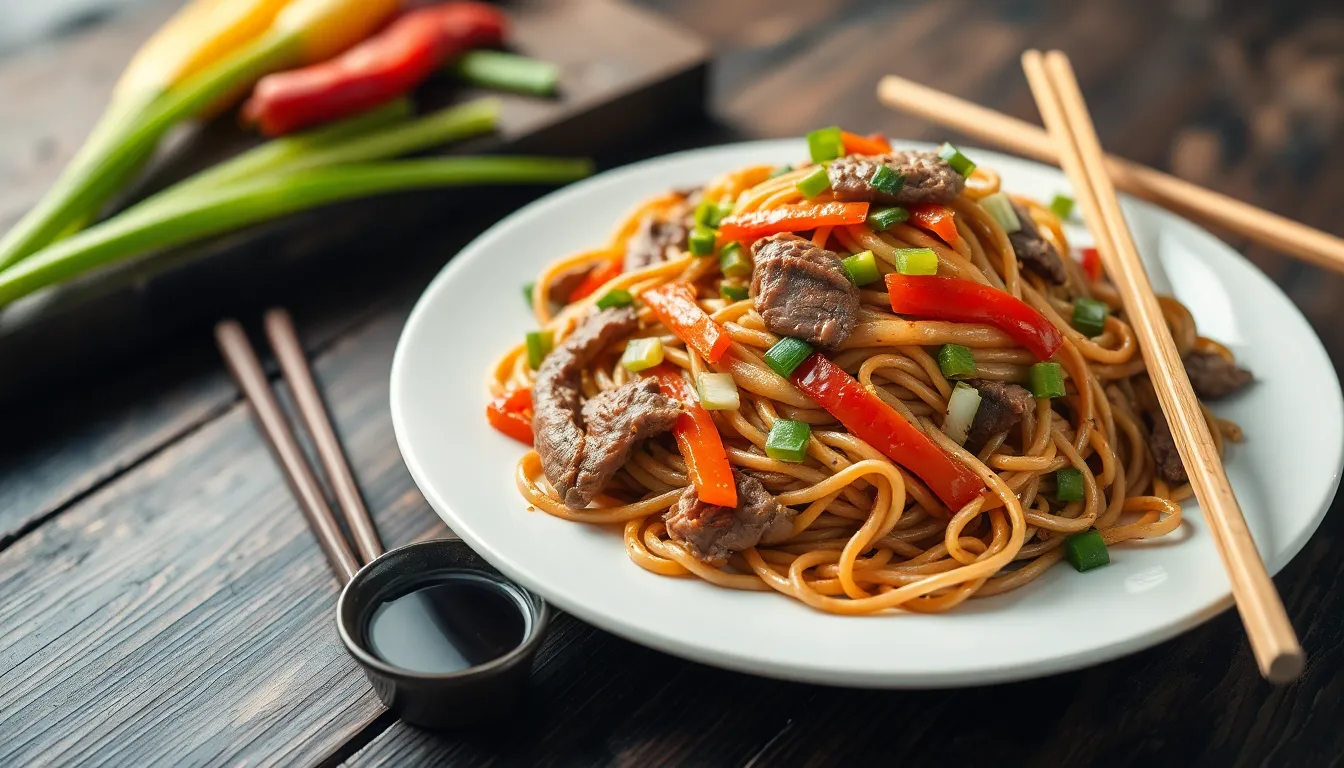
We recommend storing leftover beef chow mein properly to maintain its delicious flavors and textures for future meals. Place any remaining portions in an airtight container and refrigerate within two hours of cooking. Our testing shows that beef chow mein stays fresh and safe to eat for 2-3 days when stored correctly in the refrigerator.
When we’re ready to enjoy our leftovers, reheating requires gentle care to preserve the dish’s quality. Heat the chow mein in a microwave using medium power, stirring every 30 seconds to ensure even warming. Alternatively, we can reheat it in a skillet over medium heat, stirring occasionally to prevent sticking and ensure uniform temperature throughout.
Adding moisture during reheating helps restore the noodles’ original texture and prevents them from becoming dry or clumpy. We suggest adding a splash of water or beef broth to the dish before reheating. This technique keeps the noodles pliable and maintains the sauce’s consistency.
Freezing beef chow mein is not recommended based on our experience with noodle dishes. The noodles become mushy and lose their appealing texture when thawed, significantly diminishing the overall eating experience. Fresh preparation or proper refrigeration provides the best results for maintaining this dish’s signature taste and mouthfeel.
We always check that reheated beef chow mein reaches an internal temperature of 165°F (74°C) before serving to ensure food safety. Steam should be visible rising from the dish, and the beef should be heated through completely. These storage and reheating guidelines help us enjoy our homemade beef chow mein safely while preserving its restaurant quality flavors.
Serving Suggestions
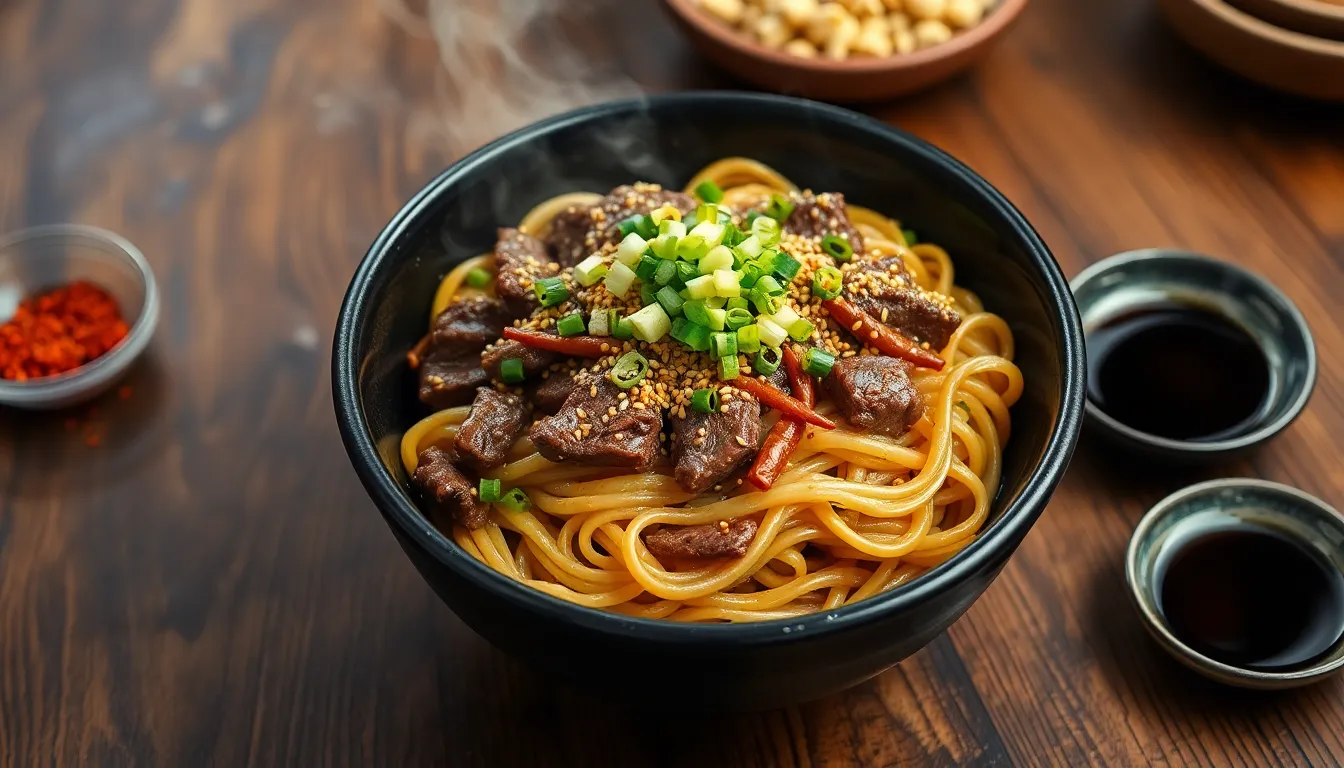
We recommend serving this beef chow mein immediately while it’s hot to capture the perfect balance of tender noodles and crisp vegetables. Fresh chopped spring onions and toasted sesame seeds make excellent garnishes that add both visual appeal and extra flavor to each bowl.
Spice lovers can sprinkle chili flakes over their portion to add heat without overwhelming the dish’s savory profile. This simple addition transforms the meal into a more exciting experience for those who enjoy bold flavors.
Complete meal pairings work wonderfully with beef chow mein since it serves as an excellent main dish. We suggest serving it alongside a light Asian cucumber salad to provide a refreshing contrast to the rich noodles. Steamed dumplings also complement the meal perfectly and create an authentic Chinese dining experience at home.
Weeknight dinner timing makes this recipe particularly valuable since it’s ready in just 15 to 20 minutes from start to finish. We find it works exceptionally well as a quick lunch option or satisfying dinner when time is limited.
Family-style serving allows everyone to customize their portions with different garnishes and heat levels. Place the chow mein in a large serving bowl and provide small dishes of additional soy sauce, sesame oil, and chili flakes so each person can adjust flavors to their preference.
Economical meal planning benefits from this recipe’s versatility with ground beef or steak strips depending on your budget and preferences. The adaptable nature of the vegetables means you can use whatever fresh produce you have available while maintaining the dish’s authentic taste and appeal.
Conclusion
We’ve shared everything you need to create restaurant-quality beef chow mein that’ll become your go-to weeknight dinner. This recipe proves that authentic Chinese flavors don’t require expensive ingredients or complicated techniques – just fresh components and the right approach.
With our detailed instructions and professional tips you’ll master the art of high-heat stir-frying and achieve that perfect balance of tender beef crisp vegetables and flavorful noodles. The versatility of this dish means you can adapt it to your family’s preferences while keeping costs low.
Now it’s time to fire up your wok and experience the satisfaction of creating takeout-quality beef chow mein in your own kitchen. Your family will be impressed and your wallet will thank you.
Frequently Asked Questions
What type of beef is best for beef chow mein?
Flank steak is the ideal choice for beef chow mein due to its tender texture when sliced thinly against the grain. Other good alternatives include sirloin or ground beef. The key is to slice the beef thinly and marinate it with soy sauce, cornstarch, and sesame oil to ensure maximum tenderness and flavor absorption.
How long does it take to make beef chow mein?
Beef chow mein can be prepared in approximately 30 minutes total, with only 7-10 minutes of active high-heat stir-frying. The preparation includes marinating the beef, chopping vegetables, making the sauce, and cooking noodles. This quick cooking time makes it perfect for busy weeknight dinners.
Can I use different types of noodles for chow mein?
Yes, you can substitute fresh chow mein noodles with various alternatives including spaghetti, yakisoba noodles, ramen noodles, or thin egg noodles. The key is to avoid overcooking them to prevent mushiness. Cook noodles until just tender, then rinse with cold water to stop the cooking process.
What vegetables work best in beef chow mein?
Traditional vegetables include onions, carrots, red bell peppers, bean sprouts, and green onions. You can also add snow peas, mushrooms, cabbage, or broccoli. Add vegetables in stages during stir-frying to maintain their crispness and prevent overcooking while ensuring even distribution throughout the dish.
How should I store leftover beef chow mein?
Store leftover beef chow mein in an airtight container in the refrigerator for 2-3 days. Reheat using medium power in the microwave or in a skillet over medium heat, adding a splash of water or broth to restore moisture. Ensure the reheated dish reaches 165°F (74°C) for food safety.
What equipment do I need to make restaurant-quality beef chow mein?
Essential equipment includes a wok or large non-stick frying pan for high-heat stir-frying, a sharp knife for precise cutting, chopsticks or spatula for stirring, mixing bowls for marinating, and a pot for boiling noodles. Having these tools ready ensures efficient cooking and authentic results.
Can I make beef chow mein spicy?
Yes, you can add heat by incorporating chili garlic sauce, sriracha, or fresh sliced chilies to the sauce mixture. You can also sprinkle red pepper flakes during cooking or serve with chili oil on the side. Start with small amounts and adjust to your preferred spice level.
What’s the secret to achieving the right sauce balance?
The perfect sauce combines light soy sauce for saltiness, dark soy sauce for color and depth, oyster sauce for umami, sesame oil for aroma, and a touch of sugar for balance. Mix all sauce ingredients beforehand and taste-test, adjusting proportions as needed to achieve your preferred flavor profile.

